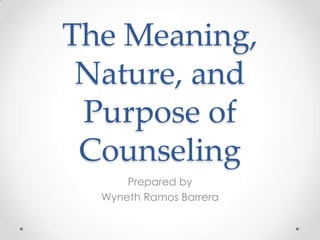This document discusses the meaning, nature, and purpose of counseling. It provides definitions of counseling from various scholars, highlighting that counseling involves a face-to-face relationship where a trained professional helps a client solve problems using communication techniques. It describes counseling as a process that utilizes tools and procedures to address a client's concerns privately and build trust. The document also outlines the nature of counseling as a collaborative relationship that allows clients to freely discuss their issues, and lists the typical purposes of counseling as helping clients better understand themselves and make decisions.



























































































































































































